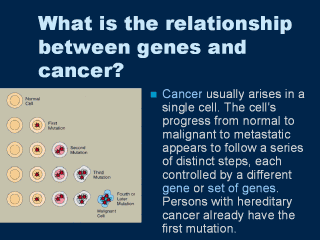|
|
|
|
front |1 |2 |3 |4 |5 |6 |7 |8 |9 |10 |11 |12 |13 |14 |15 |16 |17 |18 |19 |20 |21 |22 |23 |24 |25 |26 |27 |28 |29 |30 |31 |32 |33 |34 |35 |36 |37 |38 |39 |40 |Glossary |review |

|
Cancer is a disease of genes gone awry. Genes that control the orderly
replication of cells become damaged, allowing the cell to reproduce without
restraint and eventually to spread into neighboring tissues and set up growths
throughout the body. All cancer is genetic, in that it is triggered by altered genes. However, just a small portion of cancer is inherited: a mutation carried in reproductive cells, passed on from one generation to the next, and present in cells throughout the body. Most cancers come from random mutations that develop in body cells during one's lifetime - either as a mistake when cells are going through cell division or in response to injuries from environmental agents such as radiation or chemicals. Cancer usually arises in a single cell. The cell's progress from normal to malignant to metastatic appears to follow a series of distinct steps, each one controlled by a different gene or set of genes. Several types of genes have been implicated. Oncogenes normally encourage cell growth; when mutated or overexpressed, they can flood cells with signals to keep on dividing. Tumor-suppressor genes normally restrain cell growth; when missing or inactivated by a mutation, they allow cells to grow and divide uncontrollably. (The inherited genes that predispose for breast and ovarian cancer, Li-Fraumeni syndrome, retinoblastoma, Wilms' tumor, and familial adenomatous polyposis are malfunctioning tumor-suppressor genes.) DNA repair genes appear to trigger cancer - and perhaps other inherited disorders - not by spurring cell growth but by failing to correct mistakes that occur as DNA copies itself, letting mutations accumulate at thousands of sites. (Genes that have been linked to hereditary colon cancer are such "proofreader" genes.) |